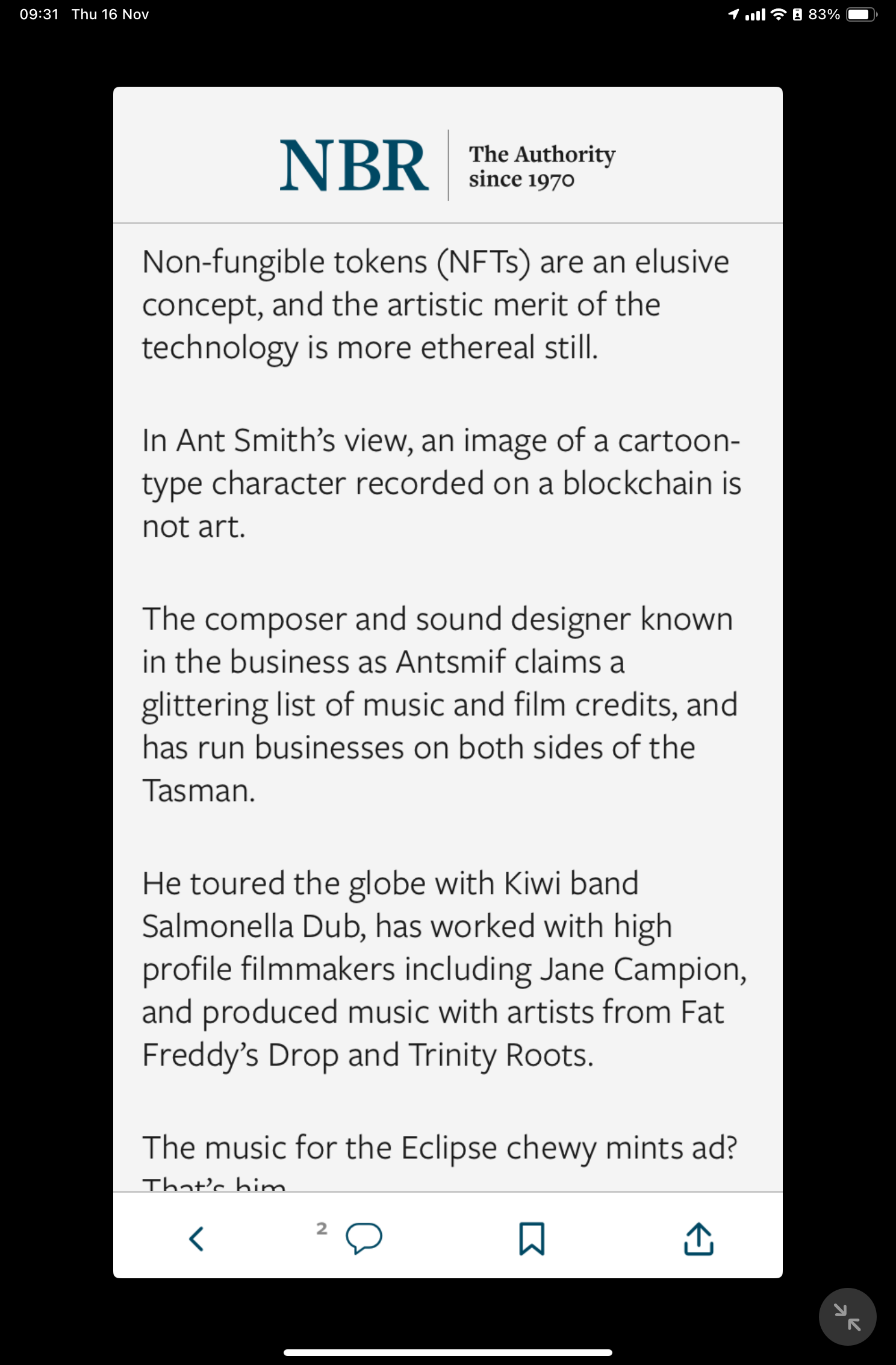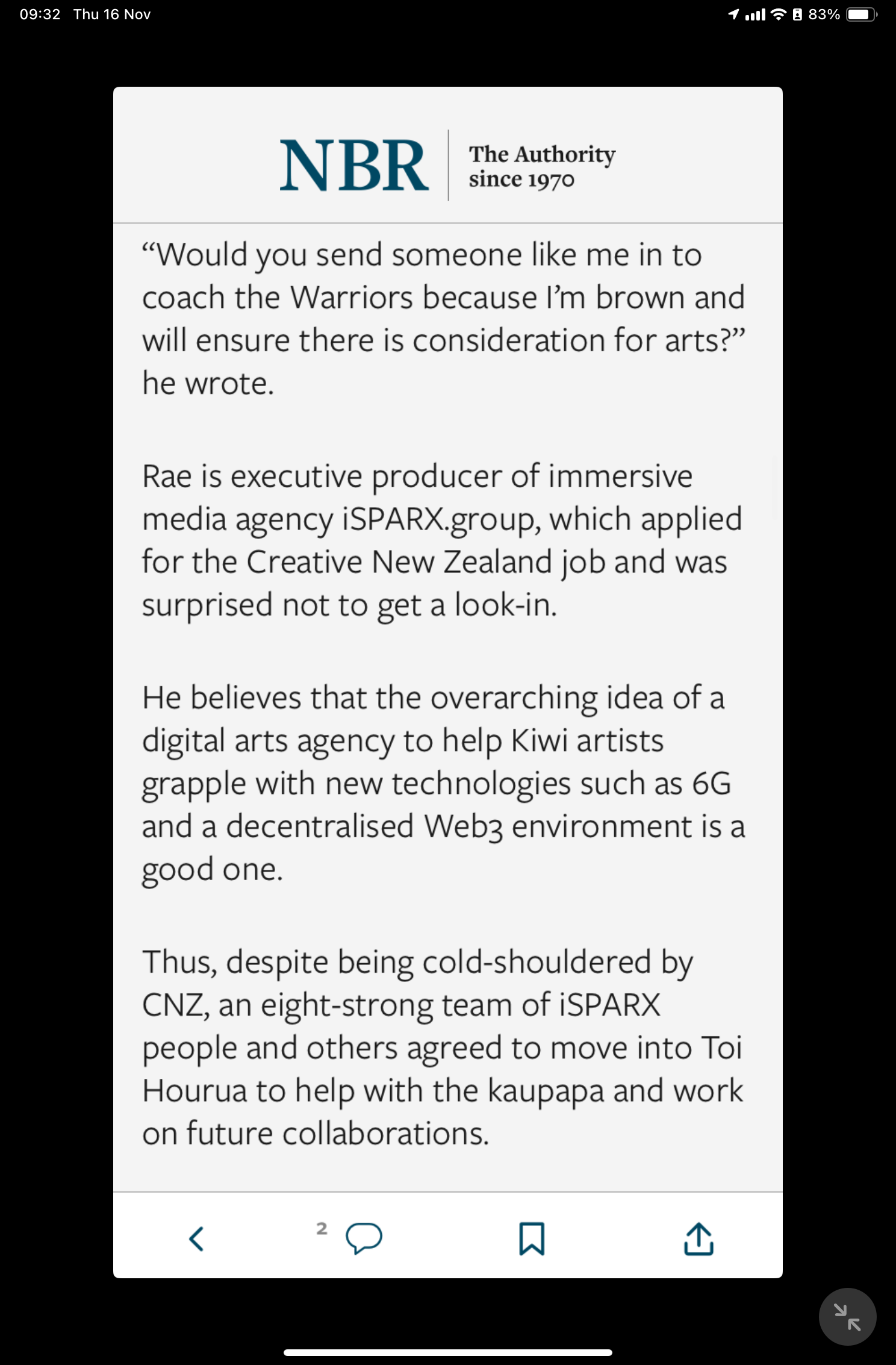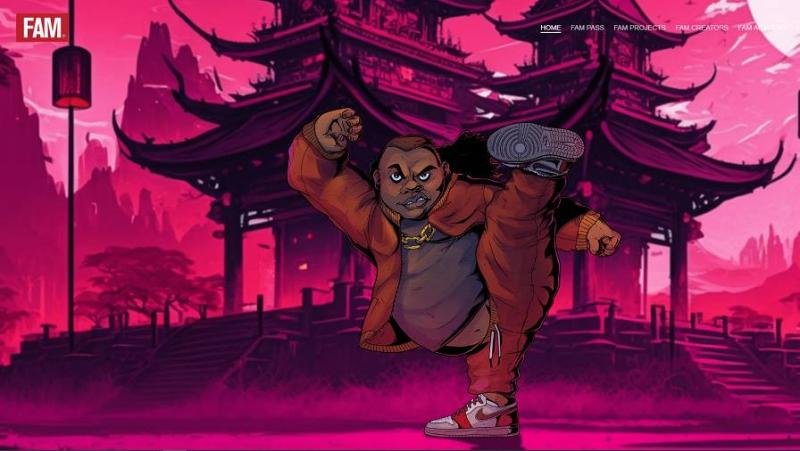Art vs design and the $5.3m Creative NZ contract
The recipient of a lucrative Covid contract to develop a digital arts agency had no experience and was more focused on NFTs, artists claim.
'Fam Pass' is an NFT scheme promoted by We Are Indigo co-owner Pat MacFie.
Thu, 16 Nov 2023
Non-fungible tokens (NFTs) are an elusive concept, and the artistic merit of the technology is more ethereal still.
In Ant Smith’s view, an image of a cartoon-type character recorded on a blockchain is not art.
The composer and sound designer known in the business as Antsmif claims a glittering list of music and film credits, and has run businesses on both sides of the Tasman.
He toured the globe with Kiwi band Salmonella Dub, has worked with high profile filmmakers including Jane Campion, and produced music with artists from Fat Freddy’s Drop and Trinity Roots.
The music for the Eclipse chewy mints ad? That’s him.
The industry veteran was bewildered that a venture awarded $5.3 million in Creative New Zealand funding seemed more focused on promoting an NFT scheme than nurturing digital skills in the arts.
That venture is Toi Hourua, a subsidiary of business advisory service We Are Indigo, which in December gained the pot of Covid recovery money to develop a Digital Arts Commissioning and Capability Service, focusing on Māori and Pasifika artists.
The directors of We Are Indigo (Indigo) are sports star Monty Beetham, former Xero executive Pat MacFie, and former longtime Icehouse head Andy Hamilton.
People in the Māori art scene had never heard of them.
In April, Smith and his former Salmonella Dub colleague, the ‘artivist’ Joff Rae, along with a collective of other digital arts practitioners, moved into Toi Hourua’s Grey Lynn premises to help.
The fledgling arts agency didn’t know what it was doing, Rae claims.
But by June, the collective had quit, and feels so strongly about the experience that it is speaking out to NBR.
Composer and sound engineer Ant Smith.
NFTs, not art
Rae is a producer of digital media who has worked on exhibitions for artists including Billy Apple, Tame Iti, and a recent ‘greatest hits’ exhibition of works by American photographer Chris Cuffaro, known for his portraits of famous musicians.
Rae has been particularly critical of Toi Hourua and has not been afraid to share those views with Indigo’s Hamilton.
The entity lacked experience and knowledge in commissioning and delivering art, and its assumptions of artistic briefs were actually design, he told Hamilton in a letter earlier this month.
“Would you send someone like me in to coach the Warriors because I’m brown and will ensure there is consideration for arts?” he wrote.
Rae is executive producer of immersive media agency iSPARX.group, which applied for the Creative New Zealand job and was surprised not to get a look-in.
He believes that the overarching idea of a digital arts agency to help Kiwi artists grapple with new technologies such as 6G and a decentralised Web3 environment is a good one.
Thus, despite being cold-shouldered by CNZ, an eight-strong team of iSPARX people and others agreed to move into Toi Hourua to help with the kaupapa and work on future collaborations.
When they began to feel like they were just there to make the place look good, they sat down with Indigo’s Pat MacFie to discuss goals, Rae and Smith say.
“Turned out, long and short, he was basically promoting this thing that was NFT-based, a cartoon,” Smith says.
“He wanted us to help him with this, which for us didn’t feel very cutting edge nor artistic.”
Fam Pass
He is referring to Fam Collective, a self-described “global media collective of indigenous creators, technologists, artists and entrepreneurs”.
One of its projects is ‘Fam’, an action-adventure franchise based around Māori and Pasifika characters going on intergalactic adventures to save the universe.
The key to the community is to purchase a ‘Fam Pass’ using crypto currency.
Only 999 passes will ever be created, with the first drop of 333 due around now, its website says.
Finn Beattie, an immersive media specialist who has worked with Rae for six years and was among those resident at the new agency, was “quite amazed at how none of the conversations I had were ever about Toi Hourua”.
“It was always about what I would have called their side gigs, Fam Pass, Fam Collectibles, whatever it’s called.
“Between the AI, the NFTs, the comments like, ‘this is going to be like Marvel’, just a complete misunderstanding of how art works, how content creation works, even how NFTs work.”
Thousands of NFT schemes have been released that are little more than digital baseball cards and are worth nothing, Rae says.
“It’s not art.
“The more we were pushing to take them away from the NFTs, and actually even considering bringing people like (a prominent arts leader) in, the more they rejected that sort of stuff.”
Digital media producer and 'artivist' Joff Rae.
Job awarded amid funding row
The Covid-19 pandemic highlighted the need for the arts and culture sector to make better use of digital technologies, and New Zealand is lagging internationally, Creative New Zealand (CNZ) says.
The aim of the four-year digital arts agency contract is to create greater resilience and prosperity for the arts, greater exposure for Aotearoa’s unique arts, and better access for remote audiences, it says.
Half of the digital agency’s commissions are to be allocated to Māori artists, 20% to Pasifika, and 10% to underserved communities.
CNZ appointed We Are Indigo (Indigo) in 2022 amid a row over government innovation agency Callaghan Innovation’s decision to reject the provider for a $2.1m contract running a startup accelerator programme.
This was based on two reports alleging Indigo and its subsidiary, Manaaki, had behaved inappropriately towards startups.
Although CNZ was aware of this it did not speak to Callaghan about it.
Indigo’s main credentials seemed to be that it had won a $125,000 pilot from Creative New Zealand earlier in the year to teach digital skills to Pasifika artists.
However, this contract was not awarded following an RFP process, but rather a ‘kaupapa Pasifika partnership approach’, CEO Stephen Wainwright confirmed to NBR at the time.
NBR has seen the two progress reports Toi Hourua has supplied to CNZ since the start of the digital arts agency contract, and neither mentions NFTs nor the Fam Collective scheme.
Indigo referred to NFTs in the proposal it made for the contract, and NFTs were a known market option for digital artists, CNZ said in a statement this week.
Toi Hourua had met all its agreed milestones to date, it said.
Toi Hourua's new chair June McCabe.
No NFTs, and moving on out
Professional director June McCabe took over as chair of Toi Hourua on November 13.
“I’m not interested in NFTs,” she says.
The agency’s three staff do not promote them, and “it is important to me that this is the case as such instruments require a competency we do not possess or wish to be involved with”.
Although Toi Hourua is wholly owned by We Are Indigo, it is a separate entity and is not involved with the Fam Collective scheme, she says.
Art and music are potential channels for getting Māori to progress on a personal continuum.
“Dependency knocks people about, it knocks the creativity out of them," she says. “I’m here because it’s unleashing a possibility for Māori.”
Another aspect of Toi Hourua’s operation which had perplexed the group of digital practitioners was its Grey Lynn premises.
To Smith, the music studio setup was cosmetic, with some expensive gear but otherwise not fit for purpose.
The performance space had a concrete floor unsuitable for dancers, and a backdrop had been printed with unlicensed pictures, meaning it couldn’t be used for many shoots, Rae says.
Rae was also baffled by the purchase of a Rokoko motion capture suit, after the collective advised Toi Hourua the technology was being superseded by Move AI which uses iPhones.
Toi Hourua is moving out of Indigo’s Grey Lynn premises, which are too big and expensive, McCabe confirms.
It is looking for something more suitable out of the central city, possibly in south Auckland.
Toi Houria also needs to “win the hearts and minds” of the arts community, she concedes.
Requests for comment to Indigo's MacFie and Hamilton went unanswered.
Artist, designer and researcher Dr Johnson Witehira.
Who?
“They’re the organisation with no track record of building anything like this at all,” Māori artist, designer, and researcher Dr Johnson Witehira says, when NBR asks him about Toi Hourua.
It was a massive surprise to the arts community when they got the CNZ job, the co-founder of Māori design agency IDIA says.
IDIA had looked at applying for it, “but the brief was so ambiguous, we just decided not even to respond, because we couldn’t really tell what Creative New Zealand wanted”.
He would have liked to see some research from CNZ into what digital skills gaps exist for Māori and Pasifika artists, before launching the agency.
He’s one of the few who’s very digital, Witehira says.
“Do lots of artists want digital skills? I don't know if they do.
“We've still got tons of painters and carvers and contemporary artists, and digital artists who do projection and film, and all kinds of stuff.
“That money should just be going directly from CNZ to artists instead of to this kind of middleman agency.”
Toi Hourua's website.
Fine art v design
Last month, a report from crypto gambling website dappGambl said the majority of NFTs were now largely worthless.
The community of financial tech experts analysed over 73,000 NFT collections and found almost 95% were valued at zero ether (the cryptocurrency used to buy them).
David Yu, founder of digital collectibles trading platform, VeVe, doesn’t like to use the word ‘collapse’, but says the NFT market is definitely experiencing a correction.
During Covid in particular, every locked-down would-be artist started issuing NFTs and it has become an issue of oversupply.
In the arts community NFTs have also suffered the stigma of being inextricably linked with crypto, but the underlying tech of the blockchain remains, and will provide a use, he predicts.
“Because the purpose for fine artists is to authenticate and put providence in a digital timestamp on these pieces of artwork," Yu says.
While there is genuine debate to be had around the role of NFTs in helping artists protect their IP, the divide remains between what is considered fine art, and what is commercial design.
“Fine art is about exploring the human condition and questioning that,” says an artist who doesn’t wish to be identified for fear of queering his pitch with CNZ.
“Design is really geared towards how you capitalise on that.”
Thu, 16 Nov 2023
Maria Slade: Senior Journalist
DDI: 09 912 2763 Mobile: 027 837 3941

































